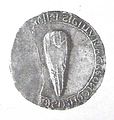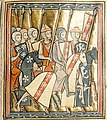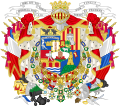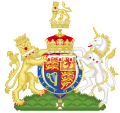History of heraldry
Western heraldry spread beyond its core territory of Latin Christendom in the 17th century, Western heraldic traditions being adopted in the Russian Empire. With colonialism, the use of heraldry has spread to other continents, e.g. Africa and the Americas.
While some concepts associated with heraldry, such as nobility and monarchy, have declined in favour of Republicanism in the 19th to 20th centuries, heraldry as a whole continues to flourish, with the art form today enjoying greater prevalence than ever in countries with strong heraldic traditions.[3] Even elsewhere, elements inherited from heraldic tradition are frequently used in national flags and emblems around the world.
Precursors
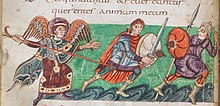
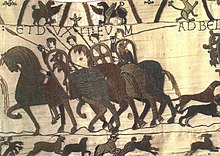
Traditions of field signs, personal emblems or seals go back to at least the Bronze Age. The ekphrastic description of shield designs in particular is found as a topos in classical literature.[4] Units of the Roman army were sometimes identified by distinctive markings on their shields.[5]
Heraldry developed in the
Western heraldry is an innovation of the 12th century. Certain members of the high nobility began to display animals, especially lions, on their shields beginning in c. the 1140s. Prior to this, western military shields of the 11th to early 12th century did sometimes show simple decorations, but not apparently tied to the personal identification of the bearer.
The
Similarly, an account of the French knights at the court of the Byzantine emperor
Proto-heraldry (12th century)
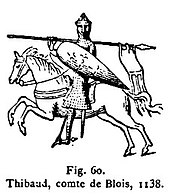
The 12th-century tradition is mostly preserved in the form of the
Seals with elements of a distinctly heraldic character begin to appear in the second third of the 12th century. A number of seals dating from between 1135 and 1155 appear to show the adoption of heraldic devices in England, France, Germany, Spain, and Italy.[13] A notable example of an early armorial seal is attached to a charter granted by Philip I, Count of Flanders, in 1164. Seals from the latter part of the eleventh and early twelfth centuries show no evidence of heraldic symbolism, but by the end of the twelfth century, seals are uniformly heraldic in nature.[10][14]
Among the oldest equestrian seals with armorials are those of
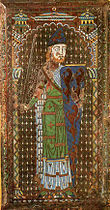
The oldest extant depiction of a coloured armoury can be seen on the tomb of Geoffrey Plantagenet, Count of Anjou, who died in 1151.[16] An enamel, probably commissioned by Geoffrey's widow between 1155 and 1160, depicts him carrying a blue shield decorated with six golden lions rampant. He wears a blue helmet adorned with another lion, and his cloak is lined in vair. A medieval chronicle states that Geoffrey was given a shield of this description when he was knighted by his father-in-law, Henry I, in 1128; but this account probably dates to about 1175.[17][18] The earliest evidence of the association of lions with the English crown is a seal bearing two lions passant, used by the future King John during the lifetime of his father, Henry II, who died in 1189.[19][20] Since Henry was the son of Geoffrey Plantagenet, it seems reasonable to suppose that the adoption of lions as an heraldic emblem by Henry or his sons might have been inspired by Geoffrey's shield. John's elder brother, Richard the Lionheart, who succeeded his father on the throne, is believed to have been the first to have borne the arms of three lions passant-guardant, still the arms of England, having earlier used two lions rampant combatant, which arms may also have belonged to his father.[21] Richard is also credited with having originated the English crest of a lion statant (now statant-guardant).[20][22]
Early mention of heraldic shields in
At least two distinctive features of heraldry are generally accepted as products of the Crusades: the surcoat, an outer garment worn over the armor to protect the wearer from the heat of the sun, was often decorated with the same devices that appeared on a knight's shield. It is from this garment that the phrase "coat of arms" is derived.[dubious ][24] Also the lambrequin, or mantling, that depends from the helmet and frames the shield in modern heraldry, began as a practical covering for the helmet and the back of the neck during the Crusades,[citation needed] serving much the same function as the surcoat. Its slashed or scalloped edge, today rendered as billowing flourishes, is thought to have originated from hard wearing in the field, or as a means of deadening a sword blow and perhaps entangling the attacker's weapon.[25]
Medieval heraldry

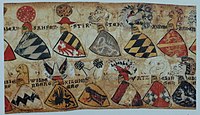
Terminology
The origin of the term heraldry itself (Middle English heraldy, Old French hiraudie), can be placed in the context of the early forms of the knightly tournaments in the 12th century. Combatants wore full armour, and identified themselves by wearing their emblems on their shields. A herald (Old French heraut, from a Frankish *hariwald "commander of an army") was an officer who would announce the competitors.
Originally a type of messenger employed by noblemen, heralds assumed the responsibility of learning and knowing the rank, pedigree, and heraldic devices of various knights and lords, as well as the rules and protocols governing the design and description, or blazoning of arms, and the precedence of their bearers.
The term coat of arms in origin refers to the surcoat with heraldic designs worn by combatants, especially in the knightly tournament, in Old French cote a armer. The sense is transferred to the heraldic design itself in Middle English, in the mid-14th century.[27]
Heraldic shield
By about the 1230s, the shields used by cavalry were almost triangular in shape, referred to as
-
Counterseal ofPales of Aragon. The shield at this time still has the "kite" shape.
-
Shield of Seedorf (late 12th century), the oldest extant medieval shield, showing a lion rampant. Preserved in Seedorf monastery, Uri, Switzerland. In origin still of the kite shield type, the top of the shield has been cut off at a later date to approximate the 13th-century "heater" shape.
-
Shield ofLion of Hesse").
-
Heraldic seal ofBouchard of Marly, dated 1225. A fully developed heraldic shield is shown on the obverse side of the seal, replacing the depiction of the fully armed knight as it were pars pro toto.
-
Royal Arms of England.
-
Miniature depicting thecrescenton his shield.
-
Example oftrimounts along with the emblems of the "orders" for which he acquired a claim to membership on his pilgrimage to Jerusalem, the Jerusalem cross for the Order of the Holy Sepulchre, the sword and scroll of the Order of the Sword, the vase with flowers emblem of the Order of the Jar and the half-wheel of Saint Catherine.
Division of the field
Coats of arms of the 13th century in some cases already include marks of
Heraldic authorities
By the middle of the fourteenth century, the principle that only a single individual was entitled to bear a particular coat of arms was generally accepted, and disputes over the ownership of arms seems to have led to gradual establishment of heraldic authorities to regulate their use. The earliest known work of
Early modern heraldry

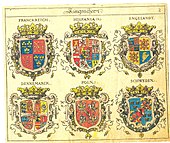
In 1484, during the reign of
Beginning in the reign of Henry VIII, the Kings of Arms were commanded to make visitations, in which they traveled about the country, recording arms borne under proper authority, and requiring those who bore arms without authority either to obtain authority for them, or cease their use. Arms borne improperly were to be taken down and defaced. The first such visitation began in 1530, and the last was carried out in 1700, although no new commissions to carry out visitations were made after the accession of William III in 1689.[30][35]
During the early modern period, heraldry became highly complex and standardised, divided into "national" traditions. Western heraldry can be divided into three large cultural groups, "Gallo-British", "German-Nordic" and "Latin". Part of the Gallo-British group are French, English and Scottish traditions. The "German-Nordic" group includes the tradition of the Holy Roman Empire and its greater sphere of influence, including German heraldry, Swedish heraldry, Norwegian heraldry, Danish heraldry, Russian heraldry, Polish heraldry, Hungarian heraldry, Croatian heraldry, Serbian heraldry, etc.
The "Latin" group includes Italian heraldry, Spanish heraldry and Portuguese heraldry.
Dutch heraldry shows influence of all three groups.
Prominent burghers and corporations, including many cities and towns, assumed or obtained grants of arms, with only nominal military associations.[36] Heraldic devices were depicted in various contexts, such as religious and funerary art, and in using a wide variety of media, including stonework, carved wood, enamel, stained glass, and embroidery.[37]
With the abandonment of the
Baroque heraldic designs became increasingly elaborate, both in terms of the increasingly complex division of the field and in terms of the surrounding achievements, culminating in the development of "landscape heraldry", incorporating realistic depictions of landscapes, during the latter part of the eighteenth and early part of the nineteenth century.
Modern heraldry
In the mid-19th century, there was a renewed interest in the history of armory, but now mostly from an antiquarian's or genealogist's perspective. This led to a re-evaluation of older designs over Baroque and Roccoco styles, a new appreciation for the medieval origins of the art.[38][39] Since the late nineteenth century, heraldry has focused on the use of varied lines of partition and little-used ordinaries to produce new and unique designs.[40]
The term "heraldry" is sometimes used to include the
-
19th-century German heraldry has examples of shields with numerous crests, as this arms of Saxe-Altenburg featuring a total of seven crests. Some thaler coins display as many as fifteen.
-
Example of complex achievements in 19th-centuryBaldomero Espartero, Prince of Vergara(1793–1879).
-
Coat of arms of the Kingdom of Prussia (1873)
-
Coat of arms of the Mexican Empire (1864)
-
Coat of arms of Prince Harry, Duke of Sussex (b. 1984, granted in September 2002, on his 18th birthday)
-
Modern coat of arms of theGraubünden, combined (marshalled) from the three older (15th to 16th century) coats of arms of the Three Leaguesin 1932.
See also
References
- ^ Octave Delepierre, Précis des annales de Bruges (1835) 38f. René of Anjou's contemporary Louis de Gruuthuse himself was a famous competitor in tournaments during the 1440s.
- ^ Fox-Davies, A Complete Guide to Heraldry, pp. 1–18.
- ^ Klackenberg, Henrik (2002), Heraldiken i folkhemmet (in Swedish), p. 6
- ^ Fox-Davies, A Complete Guide to Heraldry, pp. 6–10.
- ^ Notitia Dignitatum, Bodleian Library
- ^ "significant pre-figuration of medieval heraldry" John Onians, Atlas of World Art (2004), p. 58.
- ^ John Woodward and George Burnett, A Treatise on Heraldry: British and Foreign, W. & A. K. Johnson, Edinburgh and London (1892), vol. 1, pp. 29–31.
- ^ a b Fox-Davies, A Complete Guide to Heraldry, pp. 14–16.
- ^ Round Shield Designs (vikingage.org): "chequered" (11th c., Biblio. Mun. Avranches MS50), "flared cross" (c.1000-1050 Arras, BM MS 559 (435), vol. 1), "spirals" (c.1000-1050 Arras, BM MS 559 (435), vol. 1), "spirals with dots" (c.1000-1020 Bamberg MS A. II. 42 Bamberg Apocalypse).
- ^ a b Woodward and Burnett, vol. 1, p. 26.
- ^ Woodward and Burnett, vol. 1, p. 31.
- ^ "le blason fait son apparition dans les dernières années du XIIe siècle, brusquement, sans transition. Mais il est d’autres types plus anciens où les pièces des armoiries existent, s’annonçant pour ainsi dire avant de passer dans l’écu. Le sceau d’Enguerran, comte de Saint-Pol, antérieur à l’année 1150, est de ce nombre. Il offre déjà plusieurs gerbes dispersées dans le champ." G. Demay, Le Blason d’après les sceaux du Moyen-Âge (1877), p. 6.
- ^ Thomas Woodcock & John Martin Robinson, The Oxford Guide to Heraldry, Oxford University Press, New York (1988), p. 1.
- ^ Wagner, Heraldry in England, p. 8.
- ^ Xenja von Ertzdorff, Rudolf Schulz, Winfried Baumann, Die Romane von dem Ritter mit dem Löwen (1994), p. 175, citing Schmidt-Phiseldeck, Die Siegel des herzoglichen Hauses Braunschweig und Lüneburg, nr. 1–4.
- ^ Fox-Davies, A Complete Guide to Heraldry, p. 62.
- ^ C. A. Stothard, Monumental Effigies of Great Britain (1817) pl. 2, illus. in Anthony Wagner, Richmond Herald, Heraldry in England, Penguin (1946), pl. I.
- ISBN 9780810928305.
- ^ Woodward and Burnett, vol. 1, p. 32.
- ^ a b Fox-Davies, A Complete Guide to Heraldry, pp. 173–174.
- ^ Pastoureau, p. 59.
- ^ Woodward and Burnett, p. 37.
- König Rother, Veldecke's Eneas, and Hartmann's Erec—mostly related to the protagonists." Wandhoff (2016), (p. 57).
- ^ Fox-Davies, A Complete Guide to Heraldry, pp. 17–18.
- ^ Fox-Davies, A Complete Guide to Heraldry, pp. 17–18, 383.
- ^ a b Fox-Davies, A Complete Guide to Heraldry, pp. 27–29.
- ^ etymonline.com
- ^ De Insigniis et Armis
- ^ George Squibb, "The Law of Arms in England", in The Coat of Arms vol. II, no. 15 (Spring 1953), p. 244.
- ^ a b c Fox-Davies, A Complete Guide to Heraldry, pp. 21–22.
- ^ Woodward and Burnett, vol. 1, pp. 35–36.
- ^ Fox-Davies, A Complete Guide to Heraldry, p. 38.
- ^ a b Pastoureau, pp. 39–41.
- ^ College of Arms official website, accessed 3 March 2016.
- ^ Julian Franklyn, Shield and Crest: An Account of the Art and Science of Heraldry, London: MacGibbon & Kee (1960), p. 386.
- ^ Peter Gwynn-Jones, The Art of Heraldry: Origins, Symbols, and Designs, Parkgate Books/Barnes & Noble (1998), pp. 18–20.
- ^ Ottfried Neubecker, Heraldry: Sources, Symbols and Meaning, Macdonald and Jane's (1977), pp. 253–258.
- ^ Fox-Davies, A Complete Guide to Heraldry, pp. 87–88.
- ^ Gwynn-Jones, pp. 110–112.
- ^ Gwynn-Jones, pp. 113–121.
- Arthur Charles Fox-Davies, A Complete Guide to Heraldry, Dodge Publishing Company, New York (1909), reprinted by Bonanza Books, New York (1978), p. 1.
- Stephen Friar, Ed. A Dictionary of Heraldry. (Harmony Books, New York: 1987), p. 183.Webster's Third New International Dictionary, C. & G. Merriam Company, Cambridge, Massachusetts (1961)
- Wandhoff, "The Shield as a Poetic Screen: Early Blazon and the Visualization of Medieval German Literature" in: K. Starkey (ed.), Visual Culture and the German Middle Ages (2016), 53–72.
- Gerard J. Brault. Early Blazon. Heraldic terminology in the twelfth and thirteenth centuries, with special reference to Arthurian literature. Oxford, Oxford University Press, 1972.
- John A Goodall, "Heraldry in Italy during the Middle Ages and Renaissance", Coat of Arms 37 (January 1959).
- Burke's General Armory: "The General Armory of England, Scotland, Ireland and Wales; Comprising a Registry of Armorial Bearings from the Earliest to the Present Time," by Sir Ulster King of Armswas published in London in 1884. This roll comprises a listing of all known armory ever used in the British Isles.
- J. Siebmacher's großes Wappenbuch (continuation of the early modern Germany and Prussia; vol. 4: nobility of Austria-Hungary; vol. 5: bourgeois familial coats of arms (Germany and Switzerland); vol. 6: extinct nobility of the Holy Roman Empire; vol. 7: supplemental volume.
- Armorial Général by Jean-Baptiste Rietstap, two volumes (1884, 1887), more than 100,000 coats of arms with pan-European scope.
- Armorial of Little Russia (Малороссїйскїй гербовникъ, 1914): Ukrainian (Little Russian) family coats of arms within the Russian Empire.

